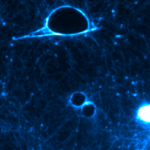Link to Pubmed [PMID] – 8806891
J. Appl. Physiol. 1996 Jun;80(6):1891-7
To better understand the different steps in the changes occurring in vascular reactivity during sepsis, we studied the effects of a short exposure to tumor necrosis factor (TNF) and interleukin-1 (IL-1) on the contraction in response to angiotensin II (ANG II). The contraction elicited by ANG II was studied by using standard isometric tension techniques in aortic rings exposed for 1 h to 25 ng/ml TNF or to 5 or 20 ng/ml IL-1. This contraction was not significantly changed by TNF but was 109 +/- 23 and 190 +/- 38% greater than in control rings after 5 and 20 ng/ml IL-1, respectively. Because the contraction induced by ANG II is modulated by the simultaneous release of prostaglandins, we tested the hypothesis that IL-1 interferes with this modulation. We found that the IL-1-induced increase in contraction in response to ANG II was completely inhibited by 10(-5) M of the cyclooxygenase inhibitor indomethacin and also by 10(-5) M of the prostaglandin H2/thromboxane A2-receptor antagonist SQ-29548. Note, however, that in rings exposed to IL-1 the contraction in response to the thromboxane A2-receptor agonist U-46619 was not significantly different from the contraction in unexposed rings. Furthermore, no loss was observed in either the vasodilator response to 10(-9)-10(-4) M of the endothelium-dependent-receptor agonist acetylcholine or in the receptor-independent contraction induced by 60 mM K+. We conclude that short exposure to IL-1, but not to TNF, produces a specific increase in the vasoconstrictor response to ANG II via mechanisms mediated by prostaglandin H2/thromboxane A2. This increase might result from an IL-1-induced shift in favor of constrictor prostanoids in the balance of the dilator/constrictor prostanoids, the release of which is associated with stimulation by ANG II.
